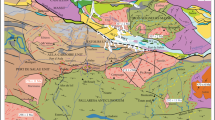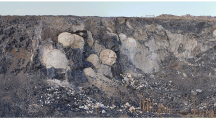Abstract
40Ar/39Ar incremental-release analyses were carried out on whole-rock and constituent white mica (illite)-rich size fractions (0.63–1 to 6.3–20 μm) within two very-low grade, penetratively cleaved metatuffs of contrasting anchizonal metamorphic grade (northeastern Rheinisches Schiefergebirge, Federal Republic of Germany). One sample from the upper anchizone displays internally concordant 40Ar/39Ar spectra with plateau ages ranging between ca. 316 and 325 Ma. These are similar to conventional K-Ar ages determined for the whole-rock and size fractions. Together the isotopic results suggest that cleavage formed at ca. 320 Ma during a concomitant very-low grade metamorphism. This is consistent with biostratigraphic controls which suggest that metamorphism and cleavage formation occurred during the Westphalian.
A metatuff sample from the middle anchizone records more internally discordant 40Ar/39Ar age spectra with total-gas ages ranging from 366 to 372 Ma. These are ca. 35–45 Ma older than corresponding conventional K-Ar ages, indicating marked recoil-loss of 39Ar occurred during irradiation. Transmission electron microscopy reveals that white mica grains within size fractions from the upper anchizone sample have clearly defined, straight edges whereas those within the middle anchizone samples are embayed and diffuse. This results in an increase in surface/volume ratio and therefore greater susceptibility for recoil-loss of 39Ar in the middle anchizone sample. Grain-edge morphology appears to be a major factor in determining the extent of recoil-loss of 39Ar during 40Ar/39Ar analysis of fine-grained size fractions.
Similar content being viewed by others
References
Ahrendt H, Hunziker JC, Weber K (1977) Age and degree of metamorphism and time of nappe emplacement along the southern margin of the Damara Orogen/Namibia (SW-Africa). Geol Rundsch 76:719–742
Ahrendt H, Hunziker JC, Weber K (1978) K/Ar-Altersbestimmungen an schwach-metamorphen Gesteinen des Rheinischen Schiefergebirges. Z Dtsch Geol Ges 129:229–247
Ahrendt H, Clauer N, Hunziker JC, Weber K (1983) Migration of folding and metamorphism in the Rheinische Schiefergebirge deduced from K-Ar and Rb-Sr age determinations. In: Martin H, Eder FW (eds) Intracontinental Fold Belts. Case studies in the Variscan Belt of Europe and the Damara Belt in Namibia. Springer, Berlin Heidelberg New York, pp 323–338
Alexander EC Jr, Michelson GM, Lanphere GA (1978) MMhb-1: a new 40Ar/39Ar dating standard. In: Zartman RE (ed) Short papers of the 4th International Conference, Geochronology, Cosmochronology, Isotope Geology. US Geol Surv Open-File Rep 72-701, pp 6–8
Bonhomme M, Prévôt L (1968) Application de la méthode Rubidium-Strontium à l'étude de l'âge radiométrique de quelques dépôts dóvonodinantiens du massif de la Bruche (Vosges du Nord). Bull Serv Carte Géol Alsace Lorraine 21:219–248
Clauer N (1974) Utilization de la méthode Rubidium-Strontium pour la datation d'une schistosité de sédiments peu métamorphisés: application au Précambrien II de la boutonnière de Bou-Azzer-El Graada (Anti-atlas, Maroc). Earth Planet Sci Lett 22:404–412
Dallmeyer RD (1982) 40Ar/39Ar ages from the Narragansett Basin and southern Rhode Island basement terrane: their bearing on the extent and timing of Alleghenian tectonothermal events in New England. Geol Soc Am Bull 93:1118–1130
Dallmeyer RD, Keppie JD (1987) Polyphase tectonothermal evolution of the southwestern Meguma Terrane, Nova Scotia: evidence from 40Ar/39Ar mineral ages. Can J Earth Sci (in press)
Dalrymple GB, Alexander EC, Lanphere MA, Kraker GP (1981) Irradiation of samples for 40Ar/39Ar dating using the Geological Survey TRIGA reactor. US Geol Surv Prof Pap 1176:55
Dodson MH, Rex DC (1971) Potassium-argon of slates and phyllites from south-west England. Q J Geol Soc London 126:465–500
Frank E, Stettler A (1979) K-Ar and 39Ar-40Ar systematics of white mica from an alpine metamorphic profile in the Swiss Alps. Schweiz Mineral Petrogr Mitt 59:375–394
Hälbich IW, Fitch FJ, Miller JA (1983) Dating the Cape Orogeny. Geol Soc S Afr Spec Publ 12:149–164
Hammerschmidt K (1982) K/Ar and 40Ar/39Ar age resolution from illites of the Trias of Mauls; Mesozoic cover of the austroalpine basement, eastern Alps (South Tyrol). Schweiz Mineral Petrogr Mitt 62:113–133
Harper CT (1964) Potassium-argon ages of slates and their geological significance. Nature 203:468–470
Harper CT (1967) The geological interpretation of K-Ar ages of metamorphic rocks from the Scottish Caledonides. Scott J Geol 3:46–66
Hunziker JC, Frey M, Clauer N, Dallmeyer RD, Friedrichsen H, Flehmig W, Hochstrasser K, Roggwiler P, Schwander H (1986) The evolution of illite to muscovite: mineralogical and isotopic data from the Glarus Alps, Switzerland. Contrib Mineral Petrol 92:157–180
Huon S (1985) Clivage ardoisier et réhomogénéisation isotopique K-Ar dans des schistes paléozoiques du Maroc — Etude microstruturale et isotopique; Conséquences régionales. Thèse, U.L.P. Strasbourg, p 124
Kralik M (1983) Interpretation of K-Ar and Rb-Sr data from fine fractions of weakly metamorphosed shales and carbonate rocks at the base of the northern calcareous Alps (Salzburg, Austria). Tschermaks Mineral Petrogr Mitt 32:49–67
Odin GS, Curry D, Gale NH, Kennedy WJ (1982) The Phanerozoic time scale in 1981. In: Odin GS (ed) Numerical dating in stratigraphy Part II. John Wiley and Sons, Chichester, England, pp 957–960
Palmer AR (1983) The decade of North American geology 1983 geologic time scale. Geology 11:503–504
Reuter A (1985) Korngrößenabhängigkeit von K-Ar Datierungen und Illit-Kristallinität anchizonaler Metapelite und assoziierter Metatuffe aus dem östlichen Rheinischen Schiefergebirge. Göttinger Arb Geol Paläont 27:91
Reuter A (1987) Implications of K-Ar ages of whole-rock and grain-size fractions of metapelites and intercalated metatuffs within an anchizonal terrane. Contrib Mineral Petrol (in press)
Reuter A, Dallmeyer RD (1987) Significance of 40Ar/39Ar age spectra of whole-rock and constituent grain-size fractions from anchizonal slates. Isot Geosci (in press)
Sedivy RA, Wampler JM, Weaver CE (1984) Potassium-Argon. In: Weaver CE (ed) Shale-slate metamorphism in southern Appalachians. Dev Petrol 10:67–97
Steiger RH, Jäger E (1977) Subcommission on geochronology: convention on the use of decay constants in geo- and cosmochronology. Earth Planet Sci Lett 36:359–362
Teichmüller M, Teichmüller R, Weber K (1979) Inkohlung und Illit-Kristallinität — Vergleichende Untersuchungen im Mesozoikum und Paläozoikum von Westfalen. Fortschr Geol Rheinl Westfalen 27:201–276
Weber K (1972) Notes on determination of illite crystallinity. Neues Jahrb Mineral Monatsh 6:267–276
Weber K (1976) Gefügeuntersuchungen an transversalgeschieferten Gesteinen aus dem östlichen Rheinischen Schiefergebirge (Ein Beitrag zur Genese der transversalen Schieferung). Geol Jahrb D15:98
Wunderlich HG (1964) Mass, Ablauf und Ursachen orogener Einengung am Beispiel des Rheinischen Schiefergebirges, Ruhrkarbons und Harzes. Geol Rundsch 54:861–882
Zimmermann T (1984) Geochronologie (K/Ar und 40Ar/39Ar) und vergleichende Geochemie von Tonfraktionen früh- und spätpräkambrischer Sedimente aus dem südlichen Afrika. Unpublished Thesis, University of Mainz, Mainz, West Germany, p 129
Author information
Authors and Affiliations
Rights and permissions
About this article
Cite this article
Reuter, A., Dallmeyer, R.D. 40Ar/39Ar dating of cleavage formation in tuffs during anchizonal metamorphism. Contr. Mineral. and Petrol. 97, 352–360 (1987). https://doi.org/10.1007/BF00371998
Received:
Accepted:
Issue Date:
DOI: https://doi.org/10.1007/BF00371998




